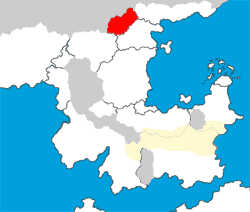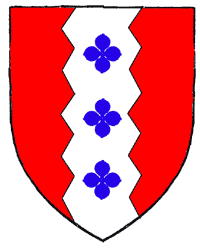Country Info: Ragnorack
 
|
| Terminology: | Ragnorackan (RAG-noh-RACK-an) people, one Ragnorackan, many Ragnorackans |
| Capital: | Northhaven |
| Monarch: | King Dmitri the Red, born 965 (Demetrius Rex Ragnoraciae*) |
| Coat of Arms: | Gules, on a pale argent invected three quatrefoils azure. |
Fifty years ago, the valley around Lake Ragnorack (RAG-noh-RACK) was wilderness. The mahiri to the north kept to themselves; the rest of the valley was filled with wolves and orcs, and no more than a handful of brave human trappers and traders. In 949 came Hrungar and the army he had assembled, determined to carve a new kingdom out of this wild valley. Through perseverance -- and the strong leadership of Hrungar -- they succeeded. The Kingdom of Ragnorack was officially founded in 951, and over the decades to follow, settlers from neighboring kingdoms would slowly begin to fill the valley with human civilization.
Ragnorackan culture is a blend of its parent cultures: Kislevian, Kjoln, and Cadfainn, although the country has been leaning towards the latter ever since King Dmitri became bethrothed to now-Queen Marilyn of Cadfaigh. Ethnic Kislevians tend to be more common the southwest, ethnic Cadfainn in the southeast, and Kjolns in the northeast. Ragnorack is one of the few places where folks won't bat an eye at a name like "Heinrich MacDougan".
Ragnorack was only founded in 951, and it is still a frontier country. It tends to be more socially fluid and less "refined" than other countries; survival is often more important than manners. Ragnorackans, much like settlers in the Wild West, take pride in having carved a civilization from the wilderness and not worrying about fancy refinements.
Ragnorackans (well, literate ones, anyway) hate it when people misspell their country's name. There is one "c" and only one "o" in Ragnorack.
History
Until the 950's, this mountain valley was mostly wilderness. The Raerock mahiri zealously guarded their enclave to the northwest, but the rest of the valley was overrun by orcs and wolves, populated by but a few human traders, and claimed by no lord.
King Hrungar (949-986) and the Conquest
In the late 940's, Hrungar the Bold, second son of a Kjoln noble, forged an alliance of settlers/conquerors (mostly other younger children of nobles) from the neighboring kingdoms of Cadfaigh, Kislevia, and Kjolnir, who would carve out a more civilized land from the northern wilderness. In return for their support, Hrungar promised them land and, in many cases, full nobility.
In the spring of 949 the armies crossed the mountain passes and began their conquest. Over the next two years they had cleared out the valley's southern reaches, and Hrungar was proclaimed King of the new kingdom of Ragnorack on July 7, 951. His first official proclamation was to lay claim to all the valley up to the claims of the neighboring kingdoms.
Over the early 950's, Hrungar encouraged settlers to move into Ragnorack from the neighboring lands. He granted baronial titles to his closest followers, land and knighthoods to many others. Over the next three decades his land continued to grow, as new settlers were first used to clear forest, then to farm. Trade with the mahiri reached record numbers; merchants found the trip to Ragnorack worthwhile when the mahiri were willing to trade their carved goods and furs for simple foodstuffs.
Hrungar's wife Anna bore him but one heir who survived infancy, Hrothgar, born in 953. He died peacefully in 986, and is much revered as the kingdom's founder.
King Hrothgar (986-992) and the Troubles
If Hrungar was a classic first-generation ruler, Hrothgar was classic second generation. Hrothgar had not had to struggle to win his throne; he was born into it, and thus lacked his father's drive, even temper and political shrewdness. Hrothgar was quick to action -- perhaps too quick -- and often failed to consider the consequences of his decrees.
Hrothgar's family was not blessed. His heir and daughter, Iren, born in 976, proved shy and weak-willed. His son Sirus, born in 977, was the victim of a curse placed on Hrothgar; the Prince was born monstrous and deformed, while the Queen died in bearing him. Sirus' blood made him crass and easily angered, and in time the prince had to be excluded from official royal visits and functions lest his behavior embarrass his grandfather Hrungar. This isolation naturally did little to improve Sirus' demeanor, and he bore open distaste for mahiri. Iren, on the other hand, proved oversensitive and almost unwilling to sit through visits with strangers. Moreover, after being saved from injury as a child by a grumwife, she held a great fondness for grum, which did little to make her father (or the nobility) comfortable with the idea of her as future Queen.
While Hrungar appreciated the gains he had made as king, Hrothgar was born to affluence and could not understand why he could not live as well as his royal peers to the south. To this end, he raised taxes to unforeseen heights. As would-be esquires proved unwilling to serve the new king, the king's forces diminished, and the Northlands soon fell to bandits, grum bands, and ackaracks. Hrungar's attempts to buy off and placate the grum, rather than conquer them, also did little to win him the favor of his subjects.
Many of the populace soon began to spread sedition and treason, even at times hinting of regicide; they were egged on by the leader of the rebels, Dennis, a young man rumored to be of aristocratic blood. Even the country's nobles began to withdraw their support for the king, whose succession grew less certain after Hrothgar abdicated for his unstable son and as his daughter Iren began to hint that she did not want the throne. Violence and banditry rose and by 992 the country had become dangerous indeed.
Hrothgar's children both disappeared in September 992; they were soon found, magically transformed into monsters by Hrothgar's enemies. While they were rescued and restored, Sirus' madness soon overcame him, and he fled the country. The never-stable and despondent king, after making an apologetic public speech on the state of the land, took his own life, publicly appointing the Captain of the Royal Guard as regent.
Hrothgar's suicide sparked further chaos, and despite the Guard's best attempts, the land denigrated into "every man for himself". Even the mahiri faced an imbalancing crisis of leadership as the elder Kervallen was killed in the growing troubles, and the elder Targa was found to be imbalanced. Princess Iren quickly renounced all claims to the throne, and thereafter left the country to find and kill her brother, saying she should have killed him as a child before he caused troubles.
The role of Regent passed to Telea, a local merchant, who hoped to be able to hold the country together until a new monarch could be determined. However, many of the country's nobles sought to use the power vacuum for their own advantage, and unifying them proved impossible. The aristocracy continued to guard their own holdings zealously and none could agree on which of Hrothgar's distant relatives -- or which of themselves -- should assume the throne. Telea, overwhelmed by the stresses of such politics, effectively gave up the regency when she departed the country virtually overnight.
Concerned by the rising chaos, Queen Gwynhafra of neighboring Cadfaigh called for a conference in the Highlands at Loch Meagan to determine Ragnorack's future. Representatives of both the Ragnorack nobility and the Raerock mahiri supported Count Dmitri von Scharhof for the throne. As third cousin, Dmitri may not have had the best claim, but Dmitri was advisor to King Gregor of Kislevia, and the conference expected that Gregor would be happy to acquire an instant ally by supplying Dmitri with troops. The conference was right, and Dmitri arrived with his army in May of 993. "The Troubles", as they came to be known, were over.
King Dmitri (993-)
The new king's forces wasted no time in rounding up the country's bandits, pushing back the beasts, and re-opening the vital roads to the southern lands so that trade might resume. Dmitri's reign has brought unprecedented prosperity to the kingdom. As word spread to other lands that the chaos synonymous the Hrothgar's reign had ended, new numbers of traders, merchants, and immigrants followed the new king northward.
Dmitri has taken a strong stand against the orcish people and has actively pushed them into the northeastern forests and hills. Dmitri makes no secret that his eventual goal is to reclaim the all the remaining orcish land and to carve new villages and baronies from them.
With the country prosperous again, expansion proceeding in the north, and support among the nobility at a high mark, Dmitri ventured into international politics again in 997. Olen MacCallad, candidate for the Cadfainn throne and leader of the "Red" faction, saw that he could force his Highlands foes to fight a two-front war if Ragnorack was to move into Cadfaigh. Olen arranged the bethrothal of his daughter and heir Marilyn to Dmitri. For Olen and Marilyn, this would give a crucial boost to their forces; for Dmitri, international prestige and considerable prosperity for his heirs.
Ragnorack entered the Cadfainn war in the spring of 997 after the bethrothal was announced; its troops had already been mustered at the border to guard against wartime banditry spreading northward out of Cadfaigh. After a year and a half of warfare (and the death of the aged Lord Olen), Dmitri and his fiancee defeated first the Blue and then the Highland faction of Golds, with the Golds' final defeat at Solkirk in August 998. The two monarchs were married in April 999 and rapidly set about to repairing the war's damage and encouraging trade between their two lands.
Their first child, Martin, was born on November 23, 1001. When his parents pass, Martin will be king of both countries. Both Cadfainn and Ragnorackans were pleased to see their respective dynasties grow more stable.
There is an extensive write-up of Ragnorack's history, available as a Word document. Please
contact the CG Game World Chair to get a copy.
Monarch
King Dmitri (the Red), born 965. Dmitri is a popular king who has brought prosperity since his coronation in 993.
Past Monarchs
King Hrungar - 949-983
King Hrothgar - 986-992
Nobles
Ruled by a King. Standard noble is the Baron, of which there are only about a dozen. There are no Counts or Dukes.
Major Cities
Northhaven, the capital, is the largest town, and the only one worth calling a "city". The towns of Lupintown, Bachburg, Borksen, Dortheburg, and Anguin are the "B-list".
Additional Details
For more information, see also "Places in Hesket: Ragnorack", a longer writeup on Ragnorack.
| * instead of "Ragnoraciae", one sometimes sees "Lupiniae" instead. (Lupinia means "land of the wolves", and was often used as the Sturian name for the wolf-filled Ragnorack Valley prior to its settlement by humans in the 950's.) |
